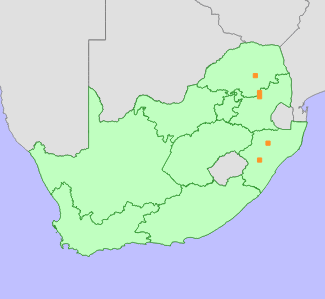| Scientific Name | Disa zuluensis Rolfe | Higher Classification | Monocotyledons | Family | ORCHIDACEAE |
National Status | Status and Criteria | Endangered B1ab(i,ii,iii,iv,v)+2ab(i,ii,iii,iv,v) | Assessment Date | 2012/08/30 | Assessor(s) | L. von Staden, D. McMurtry, L. Grobler, S. Burns & J.E. Victor | Justification | EOO 122 km², fewer than five remaining locations continue to decline due to ongoing degradation of wetlands as a result of mining, damming, grazing and alien invasive plants. |
Distribution | Endemism | South African endemic | Provincial distribution | KwaZulu-Natal, Limpopo, Mpumalanga | Range | Dundee, and Roossenekal to Dullstroom. |
Habitat and Ecology | Major system | Terrestrial | Major habitats | Income Sandy Grassland, KwaZulu-Natal Highland Thornveld, Steenkampsberg Montane Grassland, Wolkberg Dolomite Grassland, Sekhukhune Montane Grassland | Description | Swampy areas, vleis in grassland, 1500-2000 m. |
Threats | | Mining is the most serious threat to this species. There are mines on both sides of the farm on which it occurs. There are also strong indications that mining activities is are likely to extend onto this property in future (M. Lötter, pers. comm.).
Drainage lines in the area are badly invaded with wattles, and this may potentially affect the wetland habitat of this species in the future.
Water flow dynamics on the farm has also been altered by the building of dams for trout fishing tourism - Dullstroom is currently a very popular trout fishing destination.
Cattle farming around Dullstroom is impacting on wetlands where cattle trample the wetland vegetation (D. McMurtry pers. comm.). Cattle grazed in wetlands are also often responsible for eutrophication and subsequent degradation of wetlands, and aids in the spreading of alien invasive plants. |
Population | This species was originally described from KwaZulu-Natal, but it was last collected there in 1954, from an area now highly transformed through expanding human settlements and agriculture. Scott-Shaw (1999) lists Disa zuluensis as DD for KwaZulu-Natal. Currently, this species is known from a few subpopulations in the Dullstroom-Roossenekal area, where it is declining due to ongoing degradation of its wetland habitat.
| Population trend | Decreasing |
Assessment History |
Taxon assessed |
Status and Criteria |
Citation/Red List version | | Disa zuluensis Rolfe | EN B1ab(i,ii,iii,iv,v)+2ab(i,ii,iii,iv,v) | Raimondo et al. (2009) | | Disa zuluensis Rolfe | Lower Risk - Near Threatened | Victor (2002) | | Disa zuluensis Rolfe | Data Deficient | Scott-Shaw (1999) | | Disa zuluensis Rolfe | Insufficiently Known | Hilton-Taylor (1996) | | Disa zuluensis Rolfe | Uncertain | Hall et al. (1980) | |
Bibliography | Hall, A.V., De Winter, M., De Winter, B. and Van Oosterhout, S.A.M. 1980. Threatened plants of southern Africa. South African National Scienctific Programmes Report 45. CSIR, Pretoria.
Hilton-Taylor, C. 1996. Red data list of southern African plants. Strelitzia 4. South African National Botanical Institute, Pretoria.
Linder, H.P. 1981. Taxonomic studies in the Disinae. III. A revision of Disa Berg. excluding sect. Micranthae Lindl. Contributions from the Bolus Herbarium 9:1-370.
Linder, H.P. and Kurzweil, H. 1999. Orchids of southern Africa. A.A. Balkema, Rotterdam.
McMurtry, D., Grobler, L., Grobler, J. and Burns, S. 2008. Field guide to the Orchids of northern South Africa and Swaziland. Umdaus Press, Hatfield.
Raimondo, D., von Staden, L., Foden, W., Victor, J.E., Helme, N.A., Turner, R.C., Kamundi, D.A. and Manyama, P.A. 2009. Red List of South African Plants. Strelitzia 25. South African National Biodiversity Institute, Pretoria.
Scott-Shaw, C.R. 1999. Rare and threatened plants of KwaZulu-Natal and neighbouring regions. KwaZulu-Natal Nature Conservation Service, Pietermaritzburg.
Victor, J.E. 2002. South Africa. In: J.S. Golding (ed), Southern African plant Red Data Lists. Southern African Botanical Diversity Network Report 14 (pp. 93-120), SABONET, Pretoria.
|
Citation | | von Staden, L., McMurtry, D., Grobler, L., Burns, S. & Victor, J.E. 2012. Disa zuluensis Rolfe. National Assessment: Red List of South African Plants version 2024.1. Accessed on 2025/10/30 |
 Comment on this assessment Comment on this assessment
|
 © L. Grobler  © L. Ruddel  © L. Ruddel  © L. Ruddel
Search for images of Disa zuluensis on iNaturalist
|
 Comment on this assessment
Comment on this assessment


